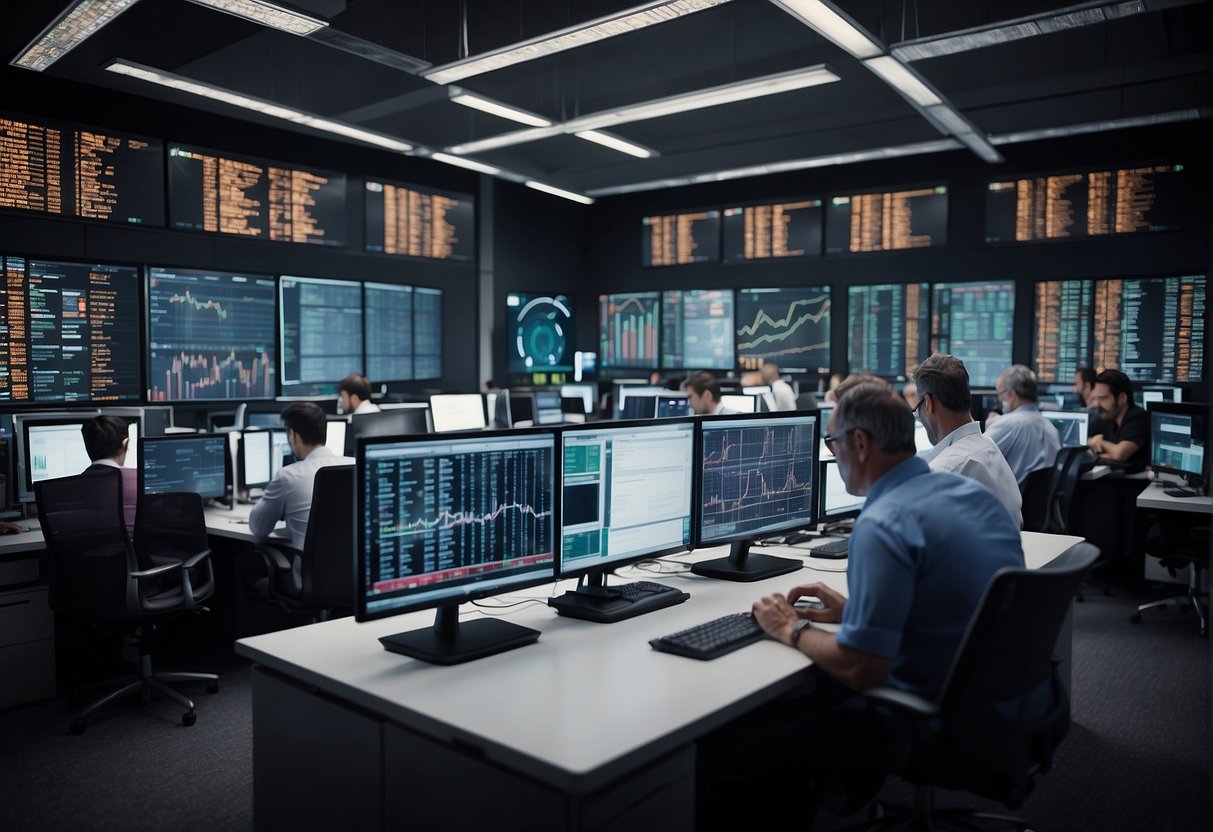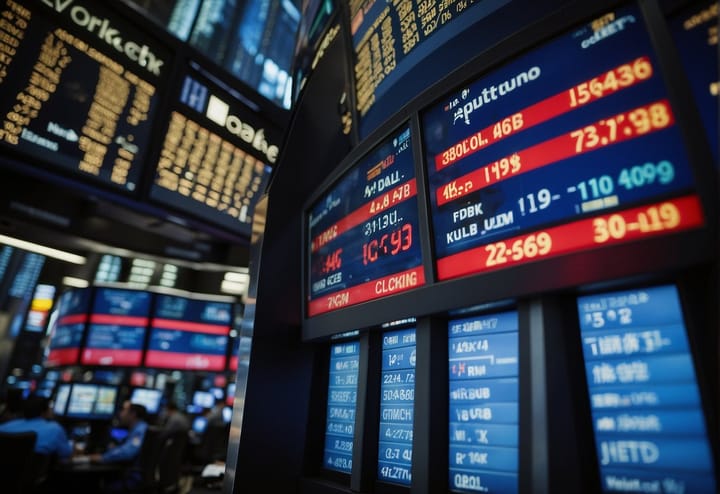Emerging Trends in Post-Trade Risk Assessment: Navigating New Challenges in Financial Markets

Emerging trends in post-trade risk assessment are increasingly critical for financial market stability and the entities that operate within this space. The post-trade phase, which includes the clearing, settlement, and reporting securities transactions, is witnessing significant shifts due to technological innovation and evolving regulatory requirements. Market participants seek new strategies to manage risks effectively while increasing efficiency and transparency in post-trade operations.

Technological advancements such as Distributed Ledger Technology (DLT) and automation are revolutionizing traditional post-trade processes. These innovations are streamlining operations and introducing new risks requiring sophisticated assessment tools. Adapting business models to incorporate these technologies while mitigating associated risks is a top priority for firms aiming to maintain a competitive edge in the rapidly changing financial landscape.
Emerging challenges in post-trade operations, such as cybersecurity threats and complex regulatory environments, necessitate a proactive approach to risk assessment. Market participants must continuously innovate their risk management strategies to keep pace with the dynamic nature of post-trade ecosystems. This comprehensive approach ensures the integrity of financial systems and fosters a more resilient marketplace.
Key Takeaways
- Technological innovation is transforming post-trade processes and risk management approaches.
- Market efficiency and risk mitigation remain central concerns for post-trade market participants.
- Continuous adaptation in risk assessment strategies is vital for maintaining market stability.
Overview of Post-Trade Processes

The post-trade process is integral to the financial markets, ensuring the secure and efficient settlement of trades. It encompasses steps that begin after a trade is executed, including clearing, settlement, and custody, and involves multiple entities to mitigate risks and uphold market integrity.
The Trade Lifecycle
The trade lifecycle refers to the sequence of processes that follow the execution of a financial transaction. Initially, trade details are confirmed by the parties involved. This is followed by the clearing stage, where a clearinghouse becomes an intermediary and guarantees the trade, significantly reducing the risk of a counterparty default. The final stage is a settlement, where the transfer of securities and cash is finalized, often involving Central Securities Depositories (CSDs) to hold and manage the securities.
Role of Financial Market Infrastructures
Financial Market Infrastructures (FMIs) are crucial in the post-trade environment. Clearinghouses, or Central Counterparties (CCPs), are instrumental in managing the risks associated with derivative and securities trades. They perform the netting of transactions to reduce the number of transactions, manage margins, and maintain a default fund to protect against member defaults. Central Securities Depositories provide the final layer of safety in post-trade processing by holding securities, ensuring their integrity and facilitating the transfer and registration of ownership.
Impact of Regulatory Reforms
Regulatory reforms have profound impacts on post-trade processes. The European Market Infrastructure Regulation (EMIR) demands reporting of derivative trades, risk mitigation techniques, and clearing through CCPs. CSD Regulation (CSDR) aims to harmonize the authorization and conduct of Central Securities Depositories across the EU, increasing safety and efficiency in securities settlement. Post-trade risk assessment is now more data-driven and transparent due to these stringent regulatory requirements shaping the post-trade landscape.
Technological Advancements in Post-Trade

The post-trade landscape is undergoing significant transformation, with advancements in technology infrastructure and automation instrumental in enhancing accuracy and speed while managing complex risk scenarios.
The Rise of Artificial Intelligence
Artificial intelligence (AI) reshapes post-trade risk assessment by enabling faster decision-making and anomaly detection. AI-driven systems can analyze vast amounts of data to identify patterns humans may overlook, resulting in more accurate risk evaluations. The integration of machine learning algorithms improves over time, continually refining the post-trade risk analysis process.
Integration of APIs and Digital Platforms
APIs (Application Programming Interfaces) have become a cornerstone in post-trade processes, allowing disparate systems to communicate effortlessly. They facilitate real-time data exchanges between trading platforms, clearinghouses, and other financial institutions. This seamless integration fosters a digitalized post-trade environment where information is swiftly and securely shared across the financial ecosystem.
Evolution of Data Management
Effective data management is fundamental to risk assessment and regulatory compliance in post-trade operations. Technological advancements have led to systems that aggregate and process large volumes of trade data. Improved data management ensures that high-quality, consistent data is available to stakeholders, leading to prompt and precise risk analysis.
Risk Management Strategies
Effective risk management strategies in post-trade processes are essential for maintaining financial stability and preventing market disruptions. These strategies are vital in addressing systemic risk and adapting to volatile market conditions through appropriate margin requirements.

Assessing Systemic Risk
Financial institutions implement robust methods to evaluate systemic risk, crucial in preventing cascading failures that can lead to a market meltdown. They leverage advanced analytics to understand the financial system's interdependencies and potential stress points. Identifying and monitoring these risks enables stakeholders to respond preemptively to emerging threats.
Margin Requirements and Volatility
Margin requirements are adjusted to reflect current market volatility, safeguarding against credit default risk. Financial entities adjust margins to be proportional to the volatility of the underlying assets, which acts as a buffer during periods of market turbulence. This strategy ensures that participants have sufficient skin in the game to cover potential losses, thereby reducing the likelihood of systemic shocks.
Market Efficiency and Transparency

The post-trade environment is being reimagined to improve market efficiency and increase transparency, addressing optimization, standardization, and enhancement.
Optimization of Post-Trade Workflow
Post-trade processes are undergoing substantial optimization to reduce settlement times and mitigate risks. Advances in technology automate routine tasks, thus allowing organizations to refocus resources on strategic analysis and decision-making. The transformation is driven by adopting new platforms and systems that streamline post-trade activities, resulting in heightened efficiency across the board.
Standardization Initiatives
Standardization has become central to achieving greater post-trade efficiency and reducing systemic risk. Regulatory bodies and industry consortia are pushing for common standards that facilitate smoother interoperability between disparate systems and entities. These initiatives are crucial for creating a consistent framework that dictates how trades are reported and shared data, ultimately leading to a more robust financial ecosystem.
Enhancing Transparency
Increasing transparency within post-trade operations is essential for market participants to assess better and manage risk. Regulatory efforts, such as those by the European Securities and Markets Authority (ESMA), underscore the importance of timely trade reporting and public disclosures, fostering a more informed and efficient market. Transparent post-trade data contributes to improved oversight and plays a significant role in upholding market integrity.
The Post-Trade Ecosystem

The post-trade ecosystem plays a critical role in maintaining the stability and efficiency of financial markets. It involves a network of institutions that provide services crucial for the integrity and functionality of trading.
The Role of Central Counterparties (CCPs)
Central counterparties (CCPs) are keystones in the post-trade ecosystem. They mitigate counterparty credit risk by becoming the buyer to every seller and the seller to every buyer in a trade, ensuring the completion of transactions even if one party defaults. CCPs contribute to financial market infrastructures, enhancing trust and reducing systemic risk through rigorous risk management practices.
Services Offered by Custodians and Depositories
Custodians and depositories provide essential services to support the post-trade environment. Custodians safeguard securities and ensure their efficient transfer, management, and settlement. Depositories manage the electronic storage of securities, facilitating dematerialization and reducing the risks associated with physical certificates. Together, they streamline post-trade processes and reinforce the ecosystem's overall steadiness.
Challenges in Post-Trade Operations

Post-trade operations face significant challenges as they strive to manage complexity, adapt to market volatility, and comply with evolving regulations.
Managing Trade Complexity
With the increase in trade complexity, post-trade processes have become more intricate. The European post-trade market has seen an uptrend in the demand for sophisticated services, particularly in handling diverse financial instruments and cross-border transactions. Enhanced systems and protocols are required to tackle the complications of complex trade structures and various transactions.
Dealing with Market Volatility
Market volatility can distort asset valuations, complicating risk assessment during the post-trade phase. Unexpected factors like COVID-19 can lead to significant market fluctuations, driving up volatility and interest rates. Effective post-trade operations require robust mechanisms to manage the impacts of inflation and sudden market shifts on settlement and clearing processes.
Navigating Through Regulatory Changes
Regulatory bodies like ESMA continually update their guidelines to ensure market stability and transparency. Navigating through these regulatory changes demands constant vigilance and adaptability from post-trade operations. Compliance with these regulations, including Basel III developments, requires systematic adjustments and a thorough understanding of the capital requirements imposed on banks and other financial institutions.
Innovations in Post-Trade Risk Assessment

The field of post-trade risk assessment has seen significant technological advancements aimed at enhancing accuracy and resilience. Innovation is particularly evident in the application of machine learning and the push for greater automation.
Applications of Machine Learning
Machine learning is increasingly applied to post-trade risk assessment to predict and mitigate potential risks. Algorithms can analyze historical and real-time data to detect anomalies indicating a risk that could affect market stability. This proactive approach not only identifies risks but can also suggest measures to counteract them before they become issues, thus strengthening the overall resilience of the post-trade environment.
Automation for Accuracy and Resilience
Automation in post-trade risk assessment ensures greater accuracy in transaction processing and compliance checks. Automated systems can handle vast volumes of trade with precision, reducing the possibility of human errors. They also contribute to organizational resilience by maintaining a steady and reliable post-trade process, even in fluctuating market conditions.
Adapting Business Models and Processes

In post-trade risk assessment, businesses are redesigning their models and processes to accommodate rapid technological advancements and shifting global economic landscapes. These adaptations are pivotal to maintaining relevance and achieving sustainable growth in an evolving market.
Impact of Technological Change
Technological advancements have substantially altered the landscape of trading processes and post-trade services. Distributed ledger technology, for example, requires firms to rethink their infrastructures to leverage new efficiencies and mitigate risks. Processes previously reliant on manual input are now automated, enhancing accuracy and cutting operational costs.
Regulatory pressures and the demand for transparency drive reform across the value chain. Businesses are adopting new subscription options and transforming their networks to remain compliant and competitive. This includes designing low-risk profiles and integrating stringent risk management frameworks.
Responding to Global Economic Trends
Global economic trends pressure business models to adapt for survival and profitability. The rise of new market participants with innovative business models has proven to be both an opportunity and a challenge for existing firms. Rarely exempt from these trends, entities must navigate by adjusting their services and value propositions.
To respond effectively, businesses evaluate their positions within the global trading ecosystem and align their services with market demands. They incorporate risk management with adaptability, aiming to reduce costs and enhance client relationships, optimizing their post-trade services accordingly. This ensures resilience against abrupt shifts in economic conditions and maintains steady growth trajectories.
Frequently Asked Questions

Technological and regulatory changes significantly influence the rapidly evolving landscape of post-trade risk management. These advancements are reshaping how risks are assessed and managed, making understanding their nuances and implications crucial.
How are technological advancements impacting the efficiency of post-trade risk management?
Technological progress in post-trade processing is revolutionizing how trades are managed after execution. Automation and integration of new software solutions are streamlining processes, reducing manual errors, and enhancing the speed of risk analysis.
What role do regulations play in shaping post-trade risk assessment procedures?
Regulations are critical in ensuring the stability and transparency of post-trade operations. They dictate the robustness of risk management protocols and enforce the implementation of standardized practices that protect against systemic risk.
What are the implications of real-time settlement systems on market risk?
The transition to real-time settlement systems significantly impacts market risk, primarily by reducing the time of exposure to counterparty and credit risks. However, it also presents a challenge by requiring systems and protocols that can operate and assess risks instantly.
How is the adoption of artificial intelligence and machine learning influencing post-trade analytics?
Artificial intelligence and machine learning are transforming post-trade analytics by enabling the more accurate and prompt processing of vast data for predictive risk modelling. These technologies also facilitate the development of more sophisticated tools for identifying and responding to potential risks.
What are the challenges and solutions in data management for post-trade risk evaluation?
Data management challenges and post-trade risk evaluation include ensuring data quality, integration, and accessibility. Solutions revolve around employing advanced data warehouses, applying stringent data governance frameworks, and implementing standardization across data sets.
In what ways are cross-border trade activities affecting post-trade risk and compliance?
Due to the varying regulatory environments, cross-border trade activities increase post-trade risk and compliance. They necessitate enhanced surveillance and cross-jurisdictional collaboration to monitor and manage the risks associated with international financial transactions.


